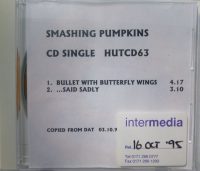Article by: SPfreaks
Article written by Derek Miller
In 1990, Smashing Pumpkins released their second single, Tristessa, on Sub Pop Records. In the United States, Tristessa was released as a 7” vinyl single. Sub Pop also released a German 12” version, which included an extra song, Honeyspider, not made available on the US pressing.
The 7” vinyl was pressed in unusually high quantities. Mass production yielded an estimated total of 7,500 copies. This number is consistent with other singles pressed at the time; however, Sub Pop has only officially confirmed 2,500 color copies on pink vinyl. More importantly, three (3) prominent colors have surfaced on the market over the years: pink, black, and gray versions(*). The gray versions are noticeably harder to come by, and might be completely accidental — right?
Collectors soon proposed a misguided, albeit completely logical, theory to explain how the gray versions came into existence. Put quite simply, the gray color is a result of the pressing plant not cleaning the plates when switching from pink to black, or vice versa. This would explain the limited quantities and also Sub Pop not officially acknowledging a gray pressing.
There is only one problem with this explanation: it is entirely false.
In order to dispel this rumor, SPfreaks teamed up with Pette Discographies, a discography site specializing in Sub Pop vinyl. Detailed below are reasons why we think this pressing was in fact intentional, and not a result of mixing pink and black vinyl.
Combining Pink and Black Vinyl Does Not Produce Gray Vinyl
Rather, the end-product is a purple hybrid. Luckily, this is not just an opinion — it’s happened before with another Sub Pop release. The color produced by combining pink and black vinyl can be seen here.
Too Many Gray Copies Exist on the Market
If the gray vinyl was the result of a color overlap, the quantities produced would be exceedingly scarce — potentially 30 to 40, at best. It will never be known exactly how many gray copies were pressed, but based purely on scarcity, it is estimated somewhere in the 200-300 range.
The Range of Color is Inconsistent with a Mistake
An erroneous pressing resulting from leftover vinyl in the plates would display a wide range of color from one copy to another. However, this is not the case. The overwhelming percentage of known copies are the same standard marbled gray color.
Sub Pop is Misleading; Often
Sometimes it’s intentional, but many times, it is not. The fact that they did not disclose a gray pressing does not mean anything. Many colors for other releases have also never been mentioned. For example, note the Afghan Whigs’ single, Sister Brother. Sub Pop talked about the red and black vinyl, but never mentioned all of the other colors that they produced. The same applies to the Nirvana Sliver single — they mentioned the blue and black version, but none of the many other variations.
Now, at this point, it all seems so cut and dry. But wait! If the gray vinyl was no accident, why do so few of them exist? Our friends at Pette Discographies offer up another suggestion:
“Now, there is the outside chance that it was a mistake, but not as previously reported. It’s remotely possible that the pressing plant started making these in a color other than the one that was specified, discovered the error, and changed over to the correct color. I have seen this happen before, but it is not that common. More likely is a scenario in which the pressing plant did not have enough of the one color (pink) to finish the order as placed, and filled out the remaining color copies ordered with a different color.”
SPfreaks would like to thank Pette Discographies for the ideas and suggestions put forth regarding this and other Sub Pop releases. However, in true collector form, we’d like for you to have a look at just a few more color variations (if you can stomach it).
Tristessa 7”: Purple Vinyl (next to Pink copy)
Tristessa 7”: Gray Vinyl (with Pink Marbling)
Tristessa 7”: Pink Vinyl (with Gray/Black Marbling)
These three examples seem to suggest that some cross-contamination did, in fact, occur when switching between pink and black pressings (as well as between the pink and gray pressings). These rare examples fall in line with all assumptions that simultaneously disqualify the gray vinyl from being an accident. Indeed, color variations exist within the Tristessa single, and are definitely worth a second viewing.
(*) Other color variations exist, but for the purposes of this article, we will concentrate solely on these three colors.






Leave a Reply
[…] 3 different colors; black, pink and grey. For anyone who is interested, in 2011 SPfreaks had an interview with Pette Discographies, a discography site specialising in Sub Pop vinyl, about this colorful 7”. Besides that, […]